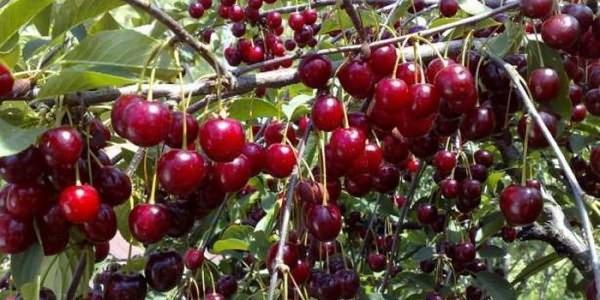We increase the yield of cherries
 To obtain a bountiful harvest of berries, fertilizers must be applied to the soil. Cherries, like all fruit trees, respond well to feeding. During the fruiting season, mineral and organic fertilizers are applied under the cherry tree. They are not often added to the soil, usually once a season.
To obtain a bountiful harvest of berries, fertilizers must be applied to the soil. Cherries, like all fruit trees, respond well to feeding. During the fruiting season, mineral and organic fertilizers are applied under the cherry tree. They are not often added to the soil, usually once a season.
Fertilizing cherries throughout the season
The first feeding of cherries is done when there is still thawed snow on the street. At 1m2 planting area make 40-50 grams of nitroammophoska or azophoska.
Advice! It is better to add compost to the soil as an organic fertilizer. Cherry assimilates plant organic matter faster than animal organics. Humus and manure are used as mulch, then they will saturate the tree with nutrients throughout the season.
Organic matter is introduced during the second feeding along with mineral fertilizers. The second feeding begins during the cherry blossom period. Potash and nitrogen fertilizers are distributed along the trunk circle.
If a lot of cherries are planted on your site, then it is better to calculate the amount of fertilizer per 1 m2 landing area. Introduce 18 grams of potash and nitrogen fertilizer into the soil. It is better to dissolve mineral fertilizers in water, so they are absorbed faster.
Then the trunk circle of each tree is covered with humus. The layer of humus must be even so that organic matter penetrates into the soil evenly, it is at least 3 cm thick, but it is very important not to bury the root collar of the tree in the mulching layer. With a deep deepening of the root collar, cherries will develop more slowly and will no longer give good yields.
Also, preferably, after flowering, add to the soil phosphorus and potash fertilizers. Then the cherry will lay more fruit buds for the next season, and the fruits will be larger.
Increased ovary
All cherry varieties require cross-pollination. Therefore, if the cherry blossoms profusely, but gives small yields, you need to plant a pollinator variety on the site. You can even plant an old, unproductive variety. Wild cherries are planted as a pollinator, but on condition that several cultivars of cherries grow on the site.
It also often happens that the berry cracks. Therefore, it rots. To prevent the cherries from cracking from excess moisture, you need to complete watering two weeks before the start of harvest.